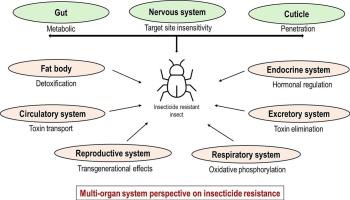超越肠道和神经机制:杀虫剂抗性的多器官系统视角
IF 4
1区 农林科学
Q2 BIOCHEMISTRY & MOLECULAR BIOLOGY
引用次数: 0
摘要
杀虫剂抗性研究通常是通过孤立的机制进行的,主要集中在靶点不敏感、代谢和表皮修饰上。然而,在了解各种器官和系统如何相互作用并共同作用以促进耐药性方面仍存在实质性差距。新兴研究强调,抗性是一种多器官现象,多种生理系统参与解毒、毒素运输、免疫调节、权衡、应激适应和在杀虫压力下的生存。本文综述了脂肪体代谢、循环运输、跨代效应、呼吸调节、马尔比氏小管排泄和内分泌调节在杀虫剂抗性形成中的作用。这些器官系统参与复杂的器官间信号和补偿机制,使抗性昆虫在保持适应性的同时减轻杀虫剂的毒性作用。多组学技术、单细胞RNA测序和先进的成像技术等研究的进步可以为这些系统适应提供更深入的见解,并有助于制定更精确和有针对性的管理策略。然而,在破译器官间通信、识别组织特异性抗性标记和开发现场诊断方法方面仍然存在挑战。通过功能基因组学、系统生物学和以微生物组为目标的战略来解决这些差距对于可持续的害虫防治至关重要。通过整合多器官系统的观点,未来的研究可以开发更有效和更有针对性的抗性管理方法,确保所使用杀虫剂的长期功效。本文章由计算机程序翻译,如有差异,请以英文原文为准。

Beyond gut and neural mechanisms: A multi-organ system perspective on insecticide resistance
Insecticide resistance has usually been studied through isolated mechanisms, primarily focusing on target-site insensitivity, metabolism and cuticular modifications. However, substantial gaps remain in understanding how various organs and systems interact and work together to contribute to resistance. Emerging research, highlights resistance as a multi-organ phenomenon, where multiple physiological systems contribute to detoxification, toxin transport, immune modulation, trade-offs, stress adaptation and survival under insecticidal pressure. This review explores the role of fat body metabolism, circulatory transport, transgenerational effects, respiratory adjustments, Malpighian tubule excretion and endocrine regulation in shaping insecticide resistance. These organ systems engage in complex inter-organ signaling and compensatory mechanisms, allowing resistant insects to mitigate the toxic effects of insecticides while maintaining fitness. Advancements in research such as multi-omics technologies, single-cell RNA sequencing and advanced imaging techniques can provide deeper insights into these systemic adaptations and help develop more precise and targeted management strategies. However, challenges remain in deciphering inter-organ communication, identifying tissue-specific resistance markers, and developing field-ready diagnostic methods. Addressing these gaps through functional genomics, systems biology, and microbiome-targeted strategies will be crucial for sustainable pest control. By integrating multi-organ system perspectives, future research can develop more effective and targeted resistance management approaches, ensuring the long-term efficacy of insecticides used.
求助全文
通过发布文献求助,成功后即可免费获取论文全文。
去求助
来源期刊
CiteScore
7.00
自引率
8.50%
发文量
238
审稿时长
4.2 months
期刊介绍:
Pesticide Biochemistry and Physiology publishes original scientific articles pertaining to the mode of action of plant protection agents such as insecticides, fungicides, herbicides, and similar compounds, including nonlethal pest control agents, biosynthesis of pheromones, hormones, and plant resistance agents. Manuscripts may include a biochemical, physiological, or molecular study for an understanding of comparative toxicology or selective toxicity of both target and nontarget organisms. Particular interest will be given to studies on the molecular biology of pest control, toxicology, and pesticide resistance.
Research Areas Emphasized Include the Biochemistry and Physiology of:
• Comparative toxicity
• Mode of action
• Pathophysiology
• Plant growth regulators
• Resistance
• Other effects of pesticides on both parasites and hosts.

 求助内容:
求助内容: 应助结果提醒方式:
应助结果提醒方式:


